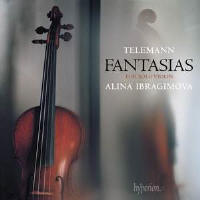Texte paru dans: / Appeared in: |
|
|
Outil de traduction |
|
|
Analyste: Michael De Sapio
No discussion of music for unaccompanied violin can omit the wonderful 12 fantasias of Georg Philipp Telemann. Published in 1735, they are conceived on a much smaller scale than Bach’s famous six solos; indeed, each fantasia is contrived so as to fit on a single page. It’s possible that Telemann never knew Bach’s great set, composed 15 years previously. Both composers relied on a well-established German tradition of violin writing, one that exploited the magical make-believe of illusionistic polyphony. Telemann alternates this contrapuntal gravitas with the lighter gallant style and moments of plain folky humor. Commentators sometimes imply that these fantasias are “easy” pieces; compared to Bach, perhaps, but they have their technical and interpretive challenges. And their musical rewards are great. The minor-key fantasias—there are four of them—are quite worthy of Bach, with slow movements that are searching, metaphysical meditations. (These are some of my own favorite pieces to play on the Baroque violin.) The remaining fantasias in major keys are full of the geniality, humor, and fun for which Telemann is known. All 12 are ingeniously composed for the instrument, filled with invention, and free in form with a protean array of miniature movements—dances, fugues, and more—which makes them truly “fantastical.” Both as a violinist and as a listener, I am grateful that Telemann wrote these rich and satisfying pieces (which can be compared to his similar fantasia sets for flute and for viola da gamba). Alina Ibragimova presumably plays from a facsimile of the original print, a page of which is reproduced in the booklet. Like many in the younger generation of musicians, she has shown a passion for historically informed performance as a sidelight to regular violin work. Here she performs on an Amati violin from 1570, a very early vintage, presumably restored to its Baroque settings and certainly tuned to historic pitch. Ibragimova is very agile of finger and bow, and brings out the vivacity, humor, and wit of these gems. The technical challenges pose no problems for her and some movements, like the Allegro of Fantasia No. 4 or the Presto of No. 12, which closes the program, are dispatched with folksy panache; indeed, in its sheer verve that Allegro might be the triumph of the whole disc. By contrast, Ibragimova is deeply introspective in the Grave of No. 6, one of the greatest movements of the set. These pieces are test cases for Baroque phrasing, “punctuation,” and musical-rhetorical timing, and Ibragimova shows complete understanding of these ideas. On the other hand, her training and experience as an all-around violinist have no doubt helped her efforts on the Baroque front. The occasional graces (ornaments) she adds to Telemann’s text are well turned, enhancing the overall experience. There is, however, an occasional bloodlessness in her tone and near-total avoidance of vibrato which you don’t hear in the playing of the older generation of Baroque violin soloists—Andrew Manze, John Holloway, Stanley Ritchie, Simon Standage, Monica Huggett, Giuliano Carmignola, et al. To my way of thinking, period string soloists should not fear a moderate and tasteful application of vibrato (the “close shake,” as Geminiani called it) in their playing for both sound quality and expressive effect. It lessens the dryness of string tone and enhances resonance and connection in the phrasing as well as adding a certain majesty. The sound quality of this disc, recorded in Henry Wood Hall in London, is excellent and realistic.
|
|




